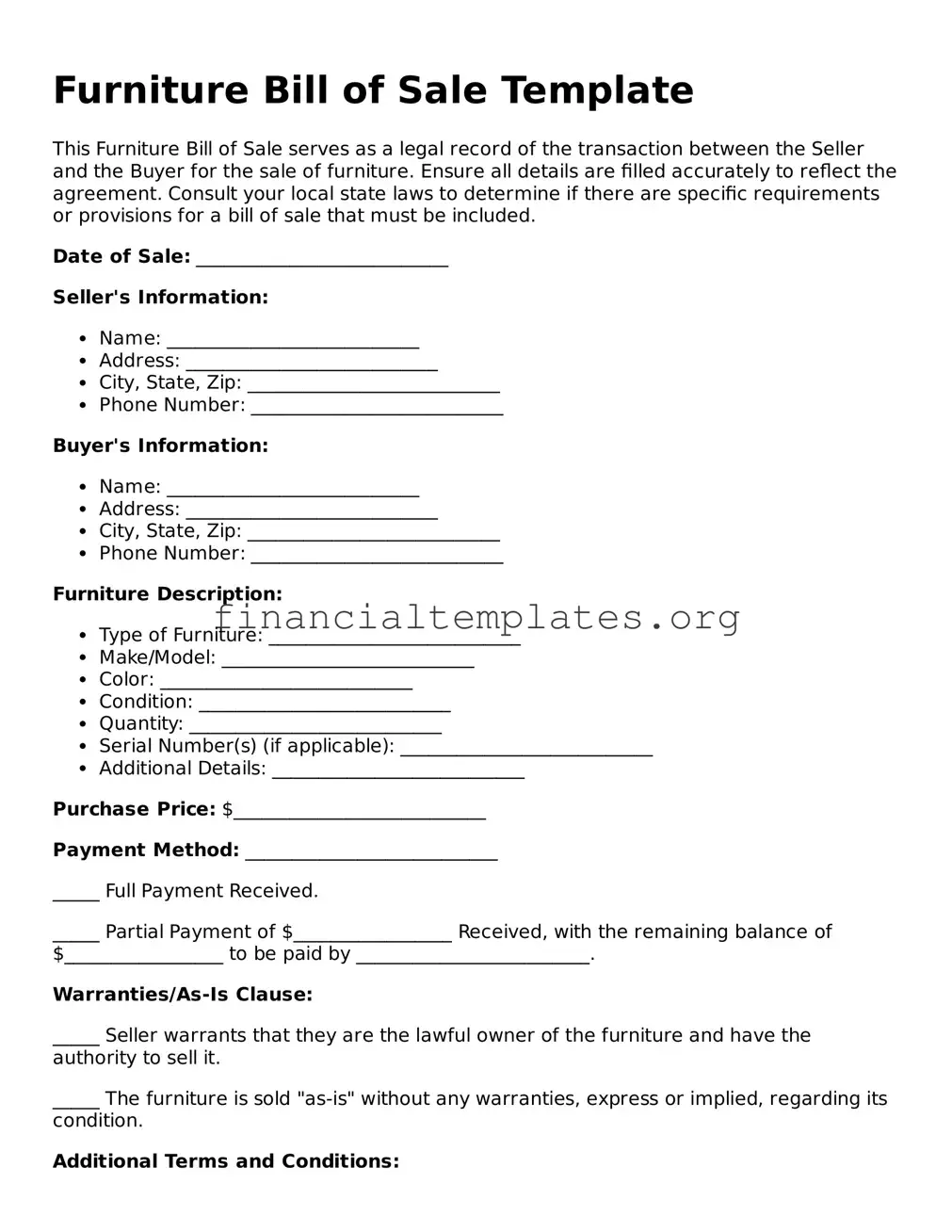The Vehicle Bill of Sale form shares similarities with the Furniture Bill of Sale, as both serve as legal documents to confirm the sale and transfer of personal property from seller to buyer. The primary difference lies in the type of property exchanged; one deals with vehicles while the other concerns furniture. Each document outlines specifics such as the sale price, a description of the item sold, and details about the buyer and seller, serving as a receipt and providing legal proof of ownership transfer.
Real Estate Purchase Agreement also aligns closely with the Furniture Bill of Sale, in the context of exchanging ownership, albeit focusing on real estate. This agreement requires more detailed information, reflecting the complexity and higher value of real estate transactions, including property descriptions, financing details, and contingencies. However, both documents ensure that the specifics of the transaction are recorded and that both parties agree to the terms, securing the exchange of ownership.
The General Bill of Sale form encapsulates a broader range of items than the Furniture Bill of Sale, not limiting itself to any specific type of property. Regardless of this breadth, its core purpose mirrors that of the Furniture Bill of Sale: to document the sale of an item and transfer ownership from the seller to the buyer, usually specifying the item, sale price, and parties involved. Both forms act as preventative measures against future disputes over the item’s ownership.
Warranty Deeds are akin to the Furniture Bill of Sale in that they also detail the transfer of property, specifically real estate, with additional assurances from the seller regarding the clear title of the property. While the Furniture Bill of Sale may or may not include warranties about the condition or ownership of the furniture, a Warranty Deed always guarantees that the property is free from liens or claims. Each serves to legally protect the buyer, though in different contexts and with varying degrees of guarantee.
Quitclaim Deeds, while primarily used in real estate transactions to transfer ownership rights without guaranteeing a clear title, share the principle of ownership transfer with the Furniture Bill of Sale. Both documents facilitate the change of ownership, although Quitclaim Deeds often involve less detailed information about the property and no guarantee about its status, contrasting with the more transactional, sale-focused nature of the Furniture Bill of Sale.
The Promissory Note is related to the Furniture Bill of Sale through its financial aspect. It represents an agreement for the borrower to repay a certain amount of money to the lender under specific conditions. In transactions where the Furniture Bill of Sale includes terms for payment over time, aspects of the Promissory Note are embedded within it, binding the buyer to fulfill their financial obligations for the purchase.
Receipts for Personal Property Sales have a direct resemblance to Furniture Bills of Sale, albeit in a more informal format. Both acknowledge the sale of items (not limited to furniture in the case of general receipts) and record the essential details: the description of the item sold, the sale price, and the parties involved. The Furniture Bill of Sale stands out by offering a more formal and legally binding document, often required for higher-value items.
Equipment Bill of Sale forms are specifically designed for the sale of equipment but share the fundamental purpose of the Furniture Bill of Sale: to provide a written record of the transaction, including the details of the item sold, the purchase price, and the identities of the seller and buyer. Both documents serve to establish the terms of the sale and transfer ownership, though the focus on equipment differentiates them from furniture-specific sales.
The Boat Bill of Sale is akin to the Furniture Bill of Sale, with the specific difference being the type of property involved. Both documents facilitate the transfer of ownership between seller and buyer, detailing the transaction's specifics, such as the item description, sale price, and party information. The Boat Bill of Sale might include additional requirements like registration numbers or certificates, reflecting the regulated nature of boat ownership.
Finally, the Pet Bill of Sale resembles the Furniture Bill of Sale in its role as a document confirming a transaction between two parties, focusing on the transfer of a living animal. It includes specifics about the pet, similar to how the Furniture Bill of Sale describes the item of furniture, and details regarding the transaction. Both are forms of agreement that safeguard the parties involved by providing a legal foundation for the transaction, differing chiefly in the subject of the sale.
